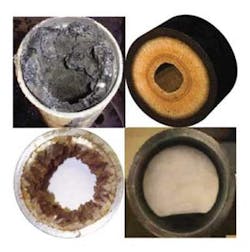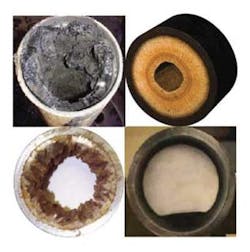Production fluid evaluation saves opex, capex
Doris L. Gonzalez, Abul Jamaluddin - Schlumberger
Trond Solbakken - StatoilHydro E&P
Walter G. Chapman - Rice University
The combination of an integrated production model with asphaltene and wax thermodynamic models improves flow assurance predictions because it accounts for changes in pressure, temperature, and composition during production life.
As hydrocarbons flow from a deepwater reservoir to the pipeline, they undergo a complex series of pressure, temperature, and compositional changes that can lead to the formation of hydrocarbon solids like asphaltenes, waxes, and hydrates. However, a systematic approach to combine downhole, surface field measurements, and laboratory analysis is the best way to determine the risks associated with precipitation of asphaltenes, waxes, and other solids, especially in an integrated production system model. Measurements can be applied to specific scenarios, saving both opex and capex.
Oilfield development has evolved from patterned drilling of dozens of wells to strategic placement of a minimum number of high quality wells. As the number of wells have decreased, the recovery per well has increased. However, the investment value of a single development well has increased exponentially, and so has the risk.
Particularly in deepwater development, flow assurance is a major factor in sustaining production and protecting the investment. Any number of problems can impair flow or even impede it altogether. In addition to the complex physical changes possible to hydrocarbons in flow from a deepwater reservoir, the associated produced waters also can contribute scale buildup on production tubulars and even on the surfaces of the reservoir rock matrix.
These are difficult problems. Hydrocarbon solid and scale deposits result from evolutionary changes as the reservoir is produced. Once they appear, they are often irreversible. The result is an expensive cleanout campaign that must be repeated increasingly frequently as the asset ages.
A systematic approach has been developed to evaluate the potential impact of production impairment from chemical deposition during production. Using the approach, a relatively small investment early in the life of a well or reservoir can prevent or moderate production interruption. Both opex and capex are affected, and both benefit from the scientific solution to the flow assurance problem.
Closing in on the source
A practical and cost-effective solution is to use logs and in situ analyses as a “triage” system to identify quickly which downhole zones require more detailed laboratory analysis. A thorough series of laboratory tests can cost hundreds of thousands of dollars. These expenses can be reduced dramatically by using optical fluid analyses and spectrographic fluid analyses available in situ from the MDT (Modular Formation Dynamics Tester) supplemented by openhole log data. When the preliminary tests are positive, PVT-quality samples can be obtained using a single-phase, multichamber sampler (SPMC). The 250 mL SPMC is able to retrieve formation fluid samples without a phase change and without crossing the asphaltene onset boundary. The sampler uses a controlled pressure compensator pre-charged with pressurized nitrogen. The pressure charge is controlled by an electrical signal from the surface initiated by the logging engineer. The charge compensates the sample for the loss of temperature it undergoes as it is retrieved from the well by keeping the sample’s pressure above the phase critical point and above the upper asphaltene flocculation point.
At surface, an onsite laboratory can perform basic fluid properties analyses. With this field quality control, operators can be sure samples obtained for laboratory testing are of sufficient quality to produce conclusive results. The result of this methodical approach can minimize the time and expense of formal laboratory testing and analysis. The cost of preventive steps to obtain flow assurance is insignificant when compared to the risk of permanent reservoir or production system damage by wax, scale, asphaltene, or hydrate deposition. In a deepwater offshore prospect, the difference between problem prevention and problem solving can be several orders of magnitude.
The fault with asphaltenes
Asphaltenes present a more complex problem, and probably make an even stronger case for a systematic approach. Asphaltene appearance is largely a function of its chemical composition. Its appearance cannot be reliably predicted using downhole measurements, but it is possible to identify which type is likely to be present so an appropriate chemical inhibition system can be implemented. In this case, knowing the magnitude of the problem is critical. It is important to determine how much chemical will be needed to prevent the appearance and deposition of asphaltenes because chemical costs over the life of the reservoir can hugely affect opex.
Recently, a deepwater development operated by StatoilHydro in the Gulf of Mexico provided an excellent example of the value of the systematic approach. In this development, two distinct hydrocarbon reservoirs were identified, each marginal as regards reserves. The deeper reservoir contained black oil, the shallower one contained gas condensate. The operator was considering a monobore solution with commingled production from the two reservoirs. The aspect of using the commingled gas promised potential added value. But commingling of gas and oil can lead to asphaltene precipitation, and this risk required careful evaluation.
Integrated production model
StatoilHydro engineers had designed an integrated production model that involved a downhole inflow control device (ICD) to control the amount of gas to be commingled. A check valve was incorporated to ensure the higher pressure oil didn’t leak into the gas reservoir. Still there were at least six production “nodes” where pressure, temperature, or phase changes could cause problems leading to solids precipitation.
Thermo-hydraulic multiphase flow modeling built a steady-state hydrodynamic model of the field. The model predicted changes in key parameters over the first five years of production with the proposed gas commingling plan implemented. When cumulative effects on pressure, temperature and gas/oil ratio (GOR) were simulated over the 28,000-ft (8,537-m) length of the production system, it showed an initial pressure drop of 15,800 psig (109 MPa) and a corresponding temperature drop of 81° F (45° C). Five years later, the the model indicated pressure drop would reduced to 8,660 psig (60 MPa) and 73° F (41° C), respectively. At the ICD, there would be an abrupt pressure and temperature drop. The initial pressure drop will be 7,000 psia (48 MPa) and the temperature will plunge 34° F (19° C) largely due to the Joule-Thompson effect. After five years, the temperature drop essentially would be the same, but the pressure drop will have declined to 5,850 psia (40 MPa).
Laboratory analyses
Detailed laboratory analyses evaluated asphaltene and wax precipitation. These included PVT analysis, saturates, aromatics, resins, and asphaltenes (SARA) analysis, wax content, wax appearance temperature (WAT), high temperature gas chromatography (HTGC), HP/HT onset determination, and gas titration using near-infrared techniques. Thermodynamic tools used to simulate asphaltene precipitation included data from fixed wavelength near-infrared, particle size analysis, and high pressure microscopy.
For WAT, a cross-polar microscope enabled the visualization of wax appearance. No single measurement yields conclusive results; they must be used in combination. For example, the SARA content of the oil reservoir fluid gives a preliminary guideline for asphaltene precipitation, and predicted a relatively asphaltene-unstable fluid. To provide the required accuracy, these data must be integrated with the gas composition information into a single model to understand the effect of commingling under dynamic conditions.
Predicting precipitation
Since the well was drilled using oil-based drilling fluids, contamination of the crude oil with mud filtrate affected asphaltene stability. Mud contaminated samples were used to measure asphaltene parameters and the compositions were corrected mathematically for the oil-based contamination to make precipitation predictions.
Finally, the onset of asphaltene precipitation for the black oil layer was measured by pressure depletion using a fixed wavelength near-infrared light-scattering system along with a high pressure microscope.
Gas titration measured fluid compatibility during commingling to determine the maximum allowable commingled gas concentration before the onset of asphaltene precipitation. The sum of all these tests indicated that asphaltene would begin to appear between 6 cc and 9 cc of added gas to 25 cc of reservoir oil at 15,000 psia (103 MPa) and 170° F (77° C) corresponding to a total GOR between 1,700 and 2,070 scf/bbl.
The wax content of the oil was measured as 1.64 wt% (STO basis), and the WAT was measured as 71° F (22° C) using a cross-polar microscope. Wax composition also was determined using the HTGC technique.
Both asphaltene and wax modeling were done so the results of expected changes could be simulated. The Perturbed Chain–Statistical Associating Fluid Theory (PC-SAFT) equation-of-state model is the thermodynamic tool used to predict asphaltene precipitation.
For asphaltenes, the simulation revealed that the mud contamination reduces the precipitation onset almost 4,000 psia (26 MPa). The clean oil will precipitate asphaltenes below 10,700 psia (74 MPa) at 184° F (84° C), but further temperature reduction would aggravate the condition. Wax phase boundaries were modeled using PVT Pro equation-of-state simulation software. After first calculating the WAT using the oil base mud-contaminated production oil, it was recalculated using STO to provide a calibration constant. Following recalibration, the fluid composition was mathematically decontaminated and the phase boundaries recalculated. The resulting maximum WAT was estimated at 102° F (39° C).
Decisions scientifically supported
Because the oil reservoir was shown to contain unstable asphaltenes and production conditions favored precipitation, a chemical inhibitor line was recommended. The addition of gas condensate aggravates asphaltene precipitation. Accordingly, commingling of production was discouraged. However, if the decision to commingle is made, the ICD is a requirement to manage the GOR within precipitation boundaries and, in any event, keep GOR below 2,200 cf/stb to reduce the amount of asphaltene precipitation. Wax precipitation should not occur if flowline temperatures are maintained above 105° F (41° C).
Editor’s Note: This a summary of SPE paper 110833 presented at the SPE annual conference and exhibition in Anaheim, California, in November 2007.


